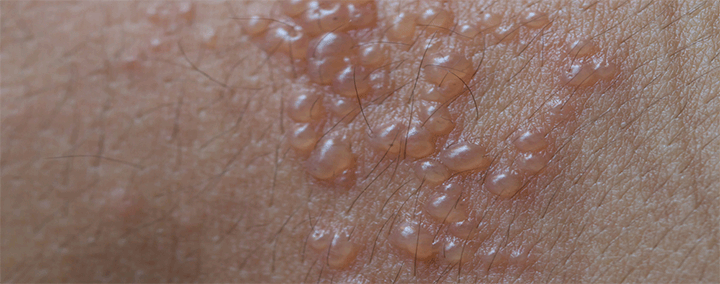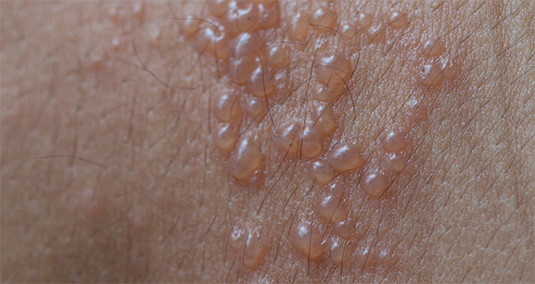Herpes zoster (HZ, also called shingles) is a painful condition that produces a maculopapular and vesicular rash. Usually, the rash appears along a single dermatome (band) around one side of the body or face.
In most cases, pain, tingling, burning, or itching occurs a few days before the rash. Next, blisters form, scabbing over in 7 to 10 days. In rare cases, the rash is widespread, resembling varicella zoster (VZ, or chickenpox) rash. Pain can range from mild to severe and may be dull, burning, or gnawing. It may last weeks, months, or even years after the blisters heal. Shingles on the face may impair vision or hearing.
According to the Centers for Disease Control and Prevention (CDC), nearly 1 million Americans get shingles each year and one in three have it during their lifetime. Caused by the same virus that causes chickenpox, shingles can occur in anyone who has had chickenpox. Most people who develop shingles have just one lifetime episode, but a small percentage have second or even third episodes.
Risk increases with age. Nearly half of shingles cases occur in people ages 60 and older; about half of those older than age 85 develop shingles. Immunocompromised persons also are at higher risk. About 100 Americans die of shingles-related causes each year, nearly all of them elderly or immunocompromised.
How shingles develops
After a person recovers from chickenpox, the VZ virus (VZV) lies dormant in the cranial nerves, dorsal roots, and sensory ganglionic neurons. If this latent virus reactivates, it moves down the nerve fibers to the skin, where it multiplies to cause the rash. VZV can spread through direct contact with the rash to someone who has never had chickenpox—typically a child, who might then get chickenpox, not shingles.
Complications
Shingles complications are more common in elderly and immunocompromised patients. One in five people with shingles develops postherpetic neuralgia (PHN)—a painful, chronic condition in the area affected by VZV. Typically, PHN lasts longer than 90 days after the shingles rash heals. Pain can be debilitating, leading to activity limitations and decreased quality of life. (See Shingles complications.)

Signs and symptoms
Signs and symptoms of shingles occur in three stages.
• Prodromal stage. Before the rash appears, patients may have pain, acute neuritis, burning, itching, numbness, tingling, a stabbing sensation, fever, chills, headache, malaise, fatigue, and extreme sensitivity on one side of body. Depression and stomach upset may occur, too.
• Active stage. A unilateral erythematous and maculopapular rash arises in one to three dermatomes, along with malaise, headache, nausea, and fever. Vesicles form within 12 to 24 hours, pustules appear in 1 to 7 days, and crusting occurs in 2 to 3 weeks. Once the crusts fall off, the skin remains erythematous and hyperpigmented or hypopigmented with scars.
• Chronic stage. After the rash resolves, PHN may occur. The pain may be constant, brief, or sharp. Pain from constant PHN usually is described as deep; brief pain as shooting or stabbing pain, possibly tic-like. Sharp pain may radiate and can be triggered by light touch.
Diagnosis
Differential diagnosis includes impetigo, contact dermatitis, folliculitis, scabies, insect bites, candidiasis, dermatitis herpetiformis, and drug eruptions. If clinical diagnosis isn’t possible, laboratory tests may be done. The gold standard for diagnosing shingles is a tissue culture, but results may take 3 to 7 days, delaying treatment. The enzyme-linked immune-sorbent assay and additional tests confirm diagnosis. Rapid diagnosis also may be obtained using polymerase chain reaction. Laboratory confirmation is mandatory for pregnant women, newborns, immunocompromised patients, and those with atypical rashes.
Treatment
The goal of treatment is to reduce pain and complications, expedite rash healing, and decrease new lesions. Treatment decreases viral shedding and risk to others in contact with the patient. It should start immediately to avoid cutaneous dissemination, PHN, and other serious complications. Starting antiviral therapy within 72 hours of rash onset reduces PHN risk. In elderly and immunocompromised patients, clinicians must act quickly to reduce the risk of cutaneous or visceral rash dissemination, prevent secondary bacterial infections, and decrease time to healing.
Up to 4% of people with shingles need to be hospitalized for I.V. antiviral therapy (acyclovir or valacyclovir) to treat or help avoid complications related to advanced age, immunosuppression, superinfection, and ocular or visceral involvement. All immunocompromised patients should receive treatment; those with organ transplants or disseminated shingles should be hospitalized for immediate I.V. antiviral therapy. Patients with neurologic complications typically receive 10 to 14 days of I.V. acyclovir therapy and are monitored closely for signs and symptoms of stroke.
In a double-blind study comparing valacyclovir therapy (1,000 mg three times daily for 7 to 14 days) to acyclovir therapy (800 mg five times daily for 7 days), the two regimens yielded similar resolution of cutaneous lesions. Valacyclovir produced a slight reduction in acute neuritis.
Cranial neuropathies should be verified by testing for VZV DNA or antiviral IgG antibody in cerebrospinal fluid. Patients may be treated with oral acyclovir, but those who are immunocompromised or have ophthalmic rash distribution require I.V. acyclovir 10 to 15 mg/kg three times daily for 5 to 7 days.
Supportive care includes use of nonadherent dressings, soothing emollients, cleansing, and compresses to reduce the risk of bacterial superinfection. (See Home care.)
Treating PHN
PHN treatment isn’t definitive. Medications used to manage shingles pain also can be used for PHN. They include antidepressants, analgesics, topical lidocaine or capsaicin, anticonvulsants, gabapentin, divalproex sodium, tramadol, and opioids. Ablation and nerve blocks or stimulators also may be given.
Preventing shingles
The shingles vaccine (Zostavax®) decreases the risk and severity of shingles, as well as the risk and severity of PHN in people who develop shingles after vaccination. It reduces shingles incidence by 64% in persons ages 60 to 69 and by 38% in those ages 70 and older. In persons ages 70 and older, it reduces PHN incidence by 67%.
A live attenuated vaccine, the vaccine is approved to prevent shingles in adults ages 50 and older and is recommended for those ages 60 and older. Studies show it’s safe and effective, with no adverse side effects except headache and minor discomfort at the injection site.
In 2015, Marin et al studied the impact of shingles vaccine in a matched case-control study. Results showed a 58% reduction in prodromal symptoms and a 61% reduction in PHN. This was the first study to show reductions in pain severity and discomfort after vaccination. Further studies are underway to determine if a shingles vaccine can be developed that will maintain its efficacy as the adult ages. A new HZ subunit vaccine (a vaccine free from viral nucleic acid that contains only specific protein subunits of the HZ virus) looks promising in maintaining efficacy at 97% and doesn’t diminish with age.
Contraindications
Contraindications for the shingles vaccine include:
• AIDS or other clinical indications of human immunodeficiency virus
• immunosuppressive therapy (including high-dose corticosteroids)
• hematopoietic stem cell transplantation
• recombinant human immune mediators and immune modulators
• current cancer treatment with radiation or chemotherapy
• bone marrow or lymphatic cancer (such as lymphoma)
• congenital or hereditary immunodeficiency
• pregnancy.
Women should avoid getting pregnant for 3 months after receiving the vaccine. Also, persons with moderate or severe acute illness (including those with a temperature of 101.3° F [38.5 ° C] or higher) should wait until they recover before getting the vaccine.
How to help patients with shingles
Singles can be extremely painful and debilitating, even decreasing quality of life. By understanding the disease, its treatment, and complications, you can help those who have this illness. To help prevent shingles, teach patients about the shingles vaccine and urge those ages 60 and older to get it.
DeSales Foster is a wound care nurse practitioner at Riddle Memorial Hospital in Media, Pennsylvania.
Selected references
Albrecht MA. Clinical manifestations of varicella-zoster virus infection: herpes zoster. UpToDate, Inc.; 2016.
Bader MS. Herpes zoster: diagnostic, therapeutic, and preventive approaches. Postgrad Med. 2013; 125(5):78-91.
Centers for Disease Control and Prevention. Shingles surveillance. August 19, 2016.
Cohen JI. A new vaccine to prevent herpes zoster. N Engl J Med. 2015;372(22):2149-50.
Cunningham AL, Lal H, Kovac M, et al; ZOE-70 Study Group. Efficacy of the herpes zoster subunit vaccine in adults 70 years of age or older. N Engl J Med. 2016;375(11):1019-32.
Devi MR, Haribabu Y, Velayudhankutty S, et al. Review on: shingles, its complications & management. Pharma Innov J. 2013;2(4):21-7.
Gilden D, Nagel M, Cohrs R, Mahalingam R, Baird N. Varicella zoster virus in the nervous system. F1000Res. 2015;4:pii.
Harpaz R, Ortega-Sanchez IR, Seward JF; Advisory Committee on Immunization Practices, Centers for Disease Control and Prevention. Prevention of herpes zoster: recommendations of the Advisory Committee on Immunization Practices (ACIP). MMWR Recomm Rep. 2008;57(RR-5):1-30.
Johnson BH, Palmer L, Gatwood J, et al. Annual incidence rates of herpes zoster among an immunocompetent population in the United States. BMC Infect Dis. 2015;15:502.
Lal H, Cunningham AL, Godeaux O, et al; ZOE-50 Study Group. Efficacy of an adjuvanted herpes zoster subunit vaccine in older adults. N Engl J Med. 2015;372(22):2087-96.
Marin M, Yawn BP, Hales CM, et al. Herpes zoster vaccine effectiveness and manifestations of herpes zoster and associated pain by vaccination status. Hum Vaccin Immunother. 2015;11(5):1157-64.
Nagel MA, Gilden D. Neurological complications of varicella zoster virus reactivation. Curr Opin Neurol. 2014;27(3):356-60.
Nagel MA, Gilden D. Update on varicella virus vasculopathy. Curr Infect Dis Rep. 2014;16(6):407.
Oxman MN, Levin MJ, Johnson GR, et al; Shingles Prevention Study Group. A vaccine to prevent herpes zoster and postherpetic neuralgia in older adults. N Engl J Med. 2005;352(22):2271-84.







